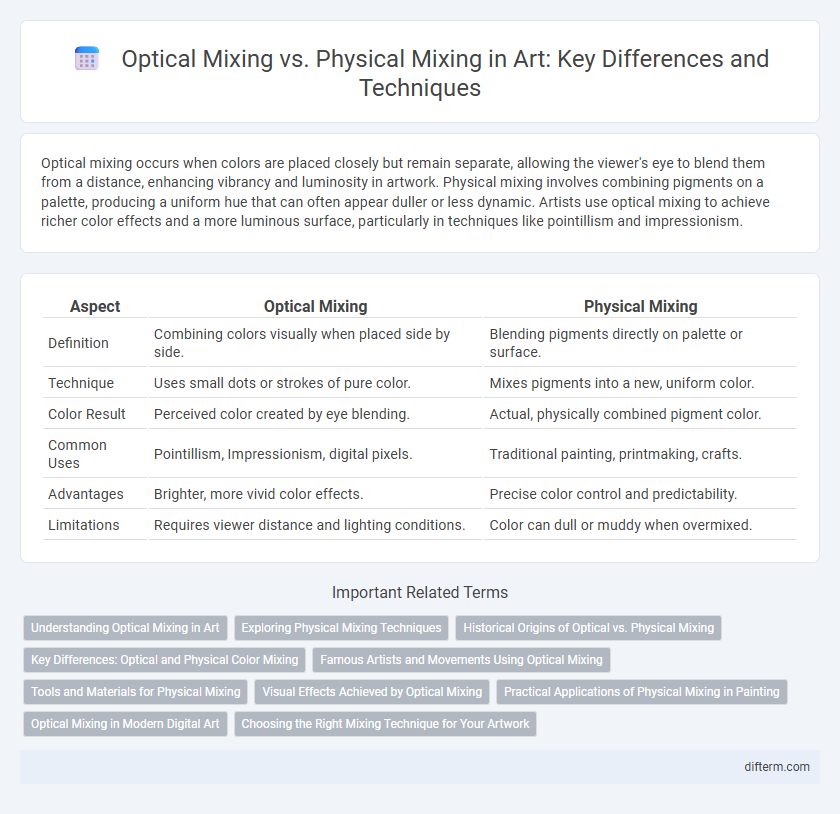Optical mixing occurs when colors are placed closely but remain separate, allowing the viewer's eye to blend them from a distance, enhancing vibrancy and luminosity in artwork. Physical mixing involves combining pigments on a palette, producing a uniform hue that can often appear duller or less dynamic. Artists use optical mixing to achieve richer color effects and a more luminous surface, particularly in techniques like pointillism and impressionism.
Table of Comparison
| Aspect | Optical Mixing | Physical Mixing |
|---|---|---|
| Definition | Combining colors visually when placed side by side. | Blending pigments directly on palette or surface. |
| Technique | Uses small dots or strokes of pure color. | Mixes pigments into a new, uniform color. |
| Color Result | Perceived color created by eye blending. | Actual, physically combined pigment color. |
| Common Uses | Pointillism, Impressionism, digital pixels. | Traditional painting, printmaking, crafts. |
| Advantages | Brighter, more vivid color effects. | Precise color control and predictability. |
| Limitations | Requires viewer distance and lighting conditions. | Color can dull or muddy when overmixed. |
Understanding Optical Mixing in Art
Optical mixing in art occurs when colors are placed closely together, allowing the viewer's eye to blend them into new hues, creating vibrant and dynamic visual effects without physically combining pigments. This technique contrasts with physical mixing, where pigments are blended on the palette, often resulting in muted or duller colors due to subtractive color mixing. Understanding optical mixing helps artists achieve luminosity and depth, enhancing the perception of light and texture in paintings.
Exploring Physical Mixing Techniques
Physical mixing techniques in art involve the direct blending of pigments on a palette or canvas, creating new hues through tactile interaction. This method allows artists to achieve textured effects and subtle color variations that optical mixing--where colors are blended visually by the observer--cannot replicate. Mastery of physical mixing enhances control over medium consistency and color saturation, vital for techniques such as impasto and glazing.
Historical Origins of Optical vs. Physical Mixing
Optical mixing originated in the late 19th century with Post-Impressionist artists like Georges Seurat, who applied tiny dots of pure color to create visual blending in the viewer's eye rather than mixing pigments physically on the palette. Physical mixing, by contrast, dates back to ancient times when artists manually blended pigments before application to achieve desired hues and effects. The historical development of optical mixing represents a shift from traditional pigment manipulation toward innovative perception-focused techniques in modern art.
Key Differences: Optical and Physical Color Mixing
Optical color mixing occurs when colors are placed side by side and blend in the viewer's eye, creating new hues through visual perception, commonly seen in pointillism and digital screens. Physical color mixing involves combining pigments or dyes directly to produce a new color, relying on subtractive color theory, which often results in muted or darker tones. The key difference lies in optical mixing preserving color vibrancy through light interaction, whereas physical mixing alters pigment properties, potentially reducing brightness.
Famous Artists and Movements Using Optical Mixing
Famous artists such as Georges Seurat and Vincent van Gogh mastered optical mixing by applying small, distinct dots or strokes of pure color that blend in the viewer's eye, a technique central to the Pointillism and Post-Impressionism movements. The Divisionists, part of late 19th-century European avant-garde, emphasized optical mixing to enhance vibrancy and luminosity, contrasting with traditional physical mixing that blends pigments on the palette. Contemporary Neo-Impressionist artists continue to explore optical mixing to achieve dynamic color effects and visual depth without altering pigment composition physically.
Tools and Materials for Physical Mixing
Physical mixing in art relies on traditional tools such as palettes, brushes, and palette knives to blend pigments directly on the surface or palette. Artists use high-quality oil paints, acrylics, or watercolors combined with mediums like linseed oil or acrylic gel to control consistency and drying time. This hands-on approach allows precise control over texture and color gradation through tactile manipulation of materials.
Visual Effects Achieved by Optical Mixing
Optical mixing creates vibrant hues and subtle color transitions by placing distinct pigments close together, allowing the viewer's eye to blend them from a distance for enhanced luminosity and depth. This technique leverages the interaction of light and color perception to produce dynamic visual effects that physical mixing often dulls by combining pigments on the palette. Optical mixing is central to Impressionist painting, where discrete brushstrokes produce shimmering, luminous scenes unattainable through traditional pigment blending.
Practical Applications of Physical Mixing in Painting
Physical mixing in painting involves blending pigments directly on the palette or canvas, creating consistent hues and textures that artists can control precisely. This technique allows for the production of unique colors and tonal variations, essential for achieving depth, realism, and subtle transitions in artworks. Practical applications include creating smooth gradients, customizing shades, and enhancing the tactile quality of paint layers, which are critical in mediums such as oil and acrylic painting.
Optical Mixing in Modern Digital Art
Optical mixing in modern digital art leverages pixel-based color blending to create vibrant visuals without physically blending pigments. This technique enables artists to simulate complex color interactions and subtle gradients by juxtaposing distinct colors at a microscopic level, enhancing depth and dynamism on digital screens. Digital platforms use algorithms to optimize optical mixing, producing highly detailed and immersive artworks that traditional physical mixing cannot replicate.
Choosing the Right Mixing Technique for Your Artwork
Optical mixing involves placing distinct colors side by side so the viewer's eye blends them, creating vibrant effects and luminosity seen in techniques like pointillism. Physical mixing combines pigments on the palette to produce a uniform color, allowing precise hue control but often resulting in duller shades. Artists should select optical mixing to enhance brightness and texture or physical mixing for smooth gradients and controlled color outcomes in their artwork.
optical mixing vs physical mixing Infographic

 difterm.com
difterm.com